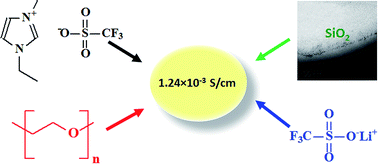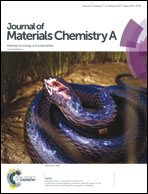Hybrid composite polymer electrolytes: ionic liquids as a magic bullet for the poly(ethylene glycol)–silica network†
Abstract
Development of polymer electrolytes, whose enhanced conductivities would allow the replacement of unstable and flammable liquid electrolytes in Li ion batteries, has received considerable attention. In this study, the incorporation of two ionic liquids (ILs), 1-butyl-3-methylimidazolium (IL1) and 1-ethyl-3-methylimidazolium (IL2), to bolster the conductivity of hybrid composite polymer electrolytes (HCPEs), based on poly(ethylene glycols) (PEGs) and organic–inorganic silica nanoparticles (OINs) formed in situ, has been investigated. The structure and conductivities of the HCPEs were found to depend on the PEG molecular weights and the amounts of ILs. HCPEs containing smaller PEG chains allow for higher conductivities, although to preserve the structural integrity of the HCPE films with 50–55 wt% of the IL, the PEG molecular weight should be 300 or higher. Frequency sweeps showed that the HCPE films are elastic and manifest a gel-like behavior. Although multiple ions are present in these HCPE, the conductivity is determined by Li ions, while the ionic liquid strongly improves the conductivity and the transference number. The HCPE containing 300 MW PEG and 55 wt% of IL2 yielded the highest conductivity of 1.24 × 10−3 S cm−1, among the best conductivities reported for polymer electrolytes with ionic liquids.



 Please wait while we load your content...
Please wait while we load your content...